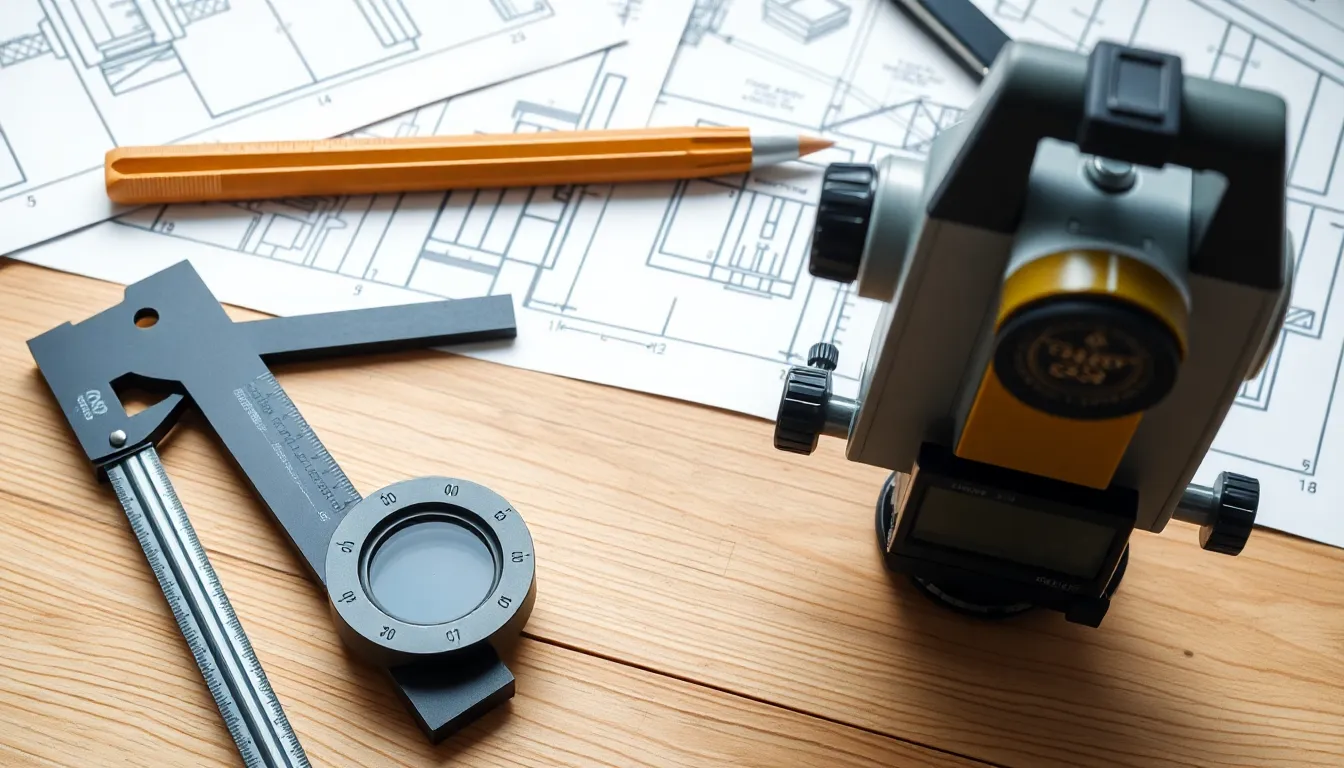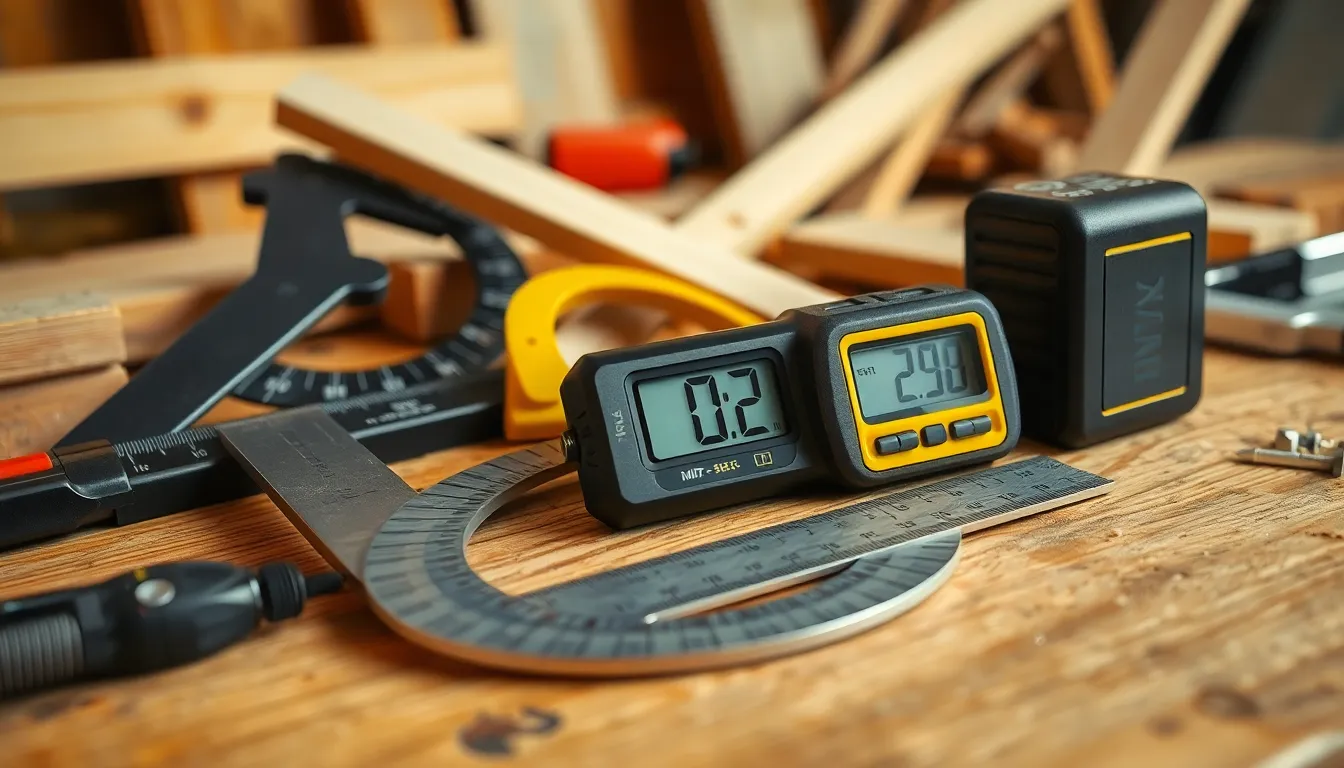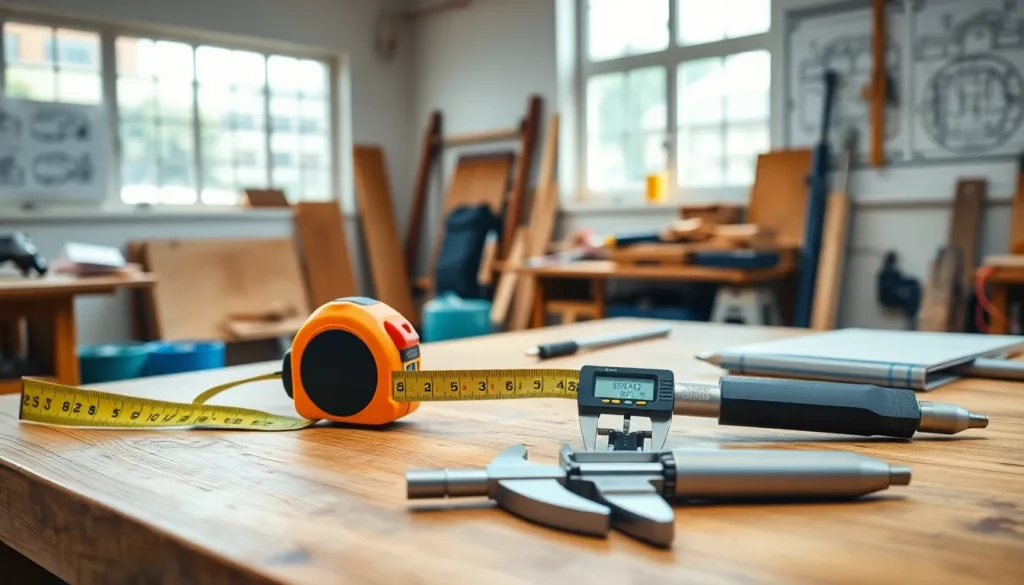Angles are everywhere, from the sharp corners of a pizza slice to the perfect tilt of a roof. But how do you measure these elusive degrees of awesomeness? Enter the world of angle-measuring tools, where precision meets practicality in the most delightful ways. Whether you’re a DIY enthusiast, a budding architect, or just someone who wants to impress friends at parties with your newfound knowledge, having the right tools can make all the difference.
Table of Contents
ToggleOverview of Tools for Measuring Angles
Various tools exist for measuring angles, each suited for different applications. Protractors remain a staple in classrooms and among DIY enthusiasts, allowing for precise angle readings. Commonly made of plastic or glass, protractors provide clear markings to measure angles from 0 to 180 degrees.
Bevel gauges serve a unique purpose, enabling users to replicate angles for projects like roofing or furniture construction. With an adjustable arm, this tool helps in transferring angles onto materials accurately.
Angle finders, often magnetic, support users in locating angles on metallic surfaces effortlessly. Whether for woodworking or metalworking, this tool enhances efficiency in measuring complex angles.
Digital angle finders, equipped with LCD displays, offer even greater convenience. They’re capable of measuring angles quickly, showing results in degrees and even radians. This technology suits tasks demanding high precision.
Theodolites, primarily used in surveying, measure both horizontal and vertical angles. Designed for large-scale projects, they provide highly accurate readings, essential for construction and land surveying.
Lastly, clinometers or inclinometer tools assist in measuring slopes and inclines effectively. These tools prove invaluable in scenarios like landscaping or construction where accurate grading is necessary.
Each tool plays a vital role in various fields, supporting precision in tasks and enhancing overall project quality. Understanding and utilizing these measuring tools leads to better outcomes, benefiting both professionals and hobbyists alike.
Types of Angle Measurement Tools

Various tools exist to measure angles, each offering unique features suited for different applications. Understanding each tool’s functionality enhances precision in projects.
Protractors
Protractors serve as essential tools in schools and various DIY projects. They typically feature a half-circle design marked with degrees from 0 to 180. Users align one side along a line, locating the angle at the intersection of the other line. Many styles include transparent materials, allowing easy overlay on drawings for accurate readings. The simplicity and accuracy provided by a protractor make it a staple for students and hobbyists alike.
Theodolites
Theodolites play a crucial role in surveying, offering both horizontal and vertical angle measurements. These precision instruments utilize telescopic sights to improve accuracy when establishing angles. With capabilities to measure angles to as small as seconds, theodolites support both construction and land surveying fields. Generally, they have a compass built-in for improved orientation and location confirmation. Their durable design ensures functionality in harsh environments, making them indispensable for professional surveyors.
Digital Angle Finders
Digital angle finders introduce modern technology to angle measurement tasks. Featuring LCD displays, they provide instant digital readouts of angles with remarkable accuracy. Most digital models come equipped with magnetic bases, allowing hands-free operation on metal surfaces. Users benefit from features like hold functions and auto shut-off to conserve battery life. Additionally, their lightweight and portable design makes them convenient for on-the-go projects, appealing to both professionals and DIY enthusiasts.
Applications of Angle Measurement Tools
Angle measurement tools serve essential functions in various fields, ensuring accuracy and precision.
Construction and Engineering
In construction and engineering, these tools play a critical role. Theodolites measure horizontal and vertical angles, which facilitates building alignment and layout. For roofing projects, bevel gauges replicate roof angles, ensuring proper installation. Angle finders also assist in checking slants for components like rafters. Digital angle finders, with their instant readouts, help speed up tasks, reducing time spent on calculations. Accurate angle measurements contribute to structural integrity, enhancing safety and durability in projects.
Woodworking and Crafting
Woodworking and crafting benefit significantly from angle measurement tools as well. Protractors help artisans create precise joints, increasing the quality of finished pieces. Bevel gauges assist in duplicating angles for cuts, ensuring consistency throughout applications. With digital tools, woodworkers can achieve accurate measurements quickly, saving time during projects. Craftsmen often employ angle finders to set up angled cuts accurately, enhancing clarity in design plans. Each tool enables greater creativity, resulting in professional and polished crafts.
Choosing the Right Tool for Your Needs
Selecting an angle-measuring tool depends on specific project requirements. Evaluate accuracy needs and budget constraints to choose effectively.
Accuracy Requirements
Precision drives the choice of tools. In tasks demanding meticulous measurements, digital angle finders or theodolites excel. They deliver instant readouts for quick validations. For woodworking or DIY projects, protractors and bevel gauges suffice, offering decent accuracy without complexity. Significant deviations can impact project quality, particularly in fields like construction or surveying. Professionals in these industries prioritize accuracy, ensuring structural integrity. Choosing a tool that aligns with the required precision level enhances both outcome and efficiency.
Budget Considerations
Costs vary widely among angle-measuring tools. Digital products often carry higher price tags due to advanced features. Basic protractors and bevel gauges, however, offer cost-effective solutions for hobbyists or students without extensive budgets. Investing in a quality theodolite or digital angle finder may benefit professionals seeking durability and precision. When balancing features with expenses, consider the frequency of use. A higher initial investment may pay off with better performance in regular applications. Ultimately, evaluate long-term benefits against short-term costs before deciding.
Selecting the right tools for measuring angles is crucial for achieving precision in various projects. Whether it’s a DIY endeavor or a professional task, understanding the unique features of each tool can significantly impact the quality of the outcome. From protractors for simple measurements to advanced digital finders for intricate tasks, there’s a suitable option for everyone.
Investing in the right angle-measuring tool not only enhances accuracy but also fosters creativity and efficiency. As individuals explore their projects, the right tools will empower them to achieve their desired results with confidence. Ultimately, the choice of tools should align with project needs and budget, ensuring that every angle is measured with precision.










